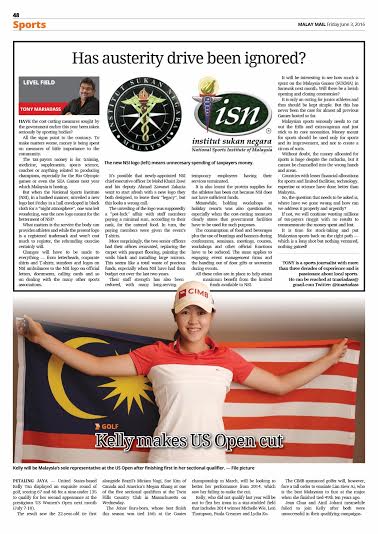Commentary
It may sound like a noble idea and a
legacy to be left behind but organising the 29th Sea Games and the 9th Asean
Para Games jointly next year can only mean chaos.
Already, last year’s Sea Games host,
Singapore, is a tough act to follow; it is said to have organised the best
Games ever. So, doing two Games together would be putting too much on our plate
and inviting unnecessary pressure.
The newly elected board of the Paralympic
Council of Malaysia (PCM), headed by president S.M. Nasarudin, has proposed to
the Olympic Council of Malaysia, and gained the support of Sports Minister
Khairy Jamaluddin, to hold a joint Games and call it the inaugural Asean Games
or “1 Asean Games”.
Bringing a joint Games to fruition
would be no mean feat. Yes, if successful, it will be a legacy for the prime
movers as they would be the first to do it. But it is going to be a nightmare
in terms of logistics and resources.
It is learnt that the prime minister
has been convinced that organising both the Games will reduce organisational
costs, especially since there will be only one opening ceremony and one closing
ceremony for both the Games. He has given the idea the nod.
Traditionally, the Para Games is held
after the Sea Games. And it is the same for the Asian and Olympics Games.
But it is the Commonwealth Games that
PCM is trying to emulate where both the Games are held jointly.
However, for the Commonwealth Games, there
are only 10 core sports on the programme and an additional seven from a list of
optional sports/disciplines while for the Para Games, there are four core
sports that must be included, and then an additional three listed as optional Para-Sports. But the events
must not exceed 20, which must be fully integrated into the overall sports programme.
Thus, the overall number of sports is
small at the Commonwealth Games and minimal at the Para Games, and thus
manageable.
While PCM have claimed they have the
full support of the Asean Paralympic Council for a joint Games, it is learnt
that it was not a unanimous decision and several officials on the PCM board do
not see the idea as feasible.
For starters, the Philippines, the
next host of the Sea Games in 2019, have come out openly to say that they do
not have the means to organise a joint Games and will host the Games
separately.
So, does this mean the joint Games
will just be for the Kuala Lumpur Games?
But before that can happen, the Sea Games
Federation (SGF), who are meeting next month in Kuala Lumpur, have to endorse
PCM’s proposal, which has to be supported by OCM.
For starters, OCM are still waiting
for a detailed proposal on how the joint Games can be organised with all the
logistics and resource details to be studied before presenting at the SGF
meeting.
OCM have been given preliminary brief
by PCM saying that except for athletics and swimming, all other events can he
held at the same venue for both Games.
Among the issues that need to be
addressed are:
* Whether the duration of the Games
will have to be extended because of the number of events. For instance, for
athletics and swimming, Sea Games will see 46 and 38 respectively while for the
Para Games, it will be a total of 95 events for athletics (because of the items
for a single event under various categories, that is for the 100m there will be
21 events!) and 91 for swimming.
A total of 16 sports have been
proposed for the Para Games with a total of 240 events for men and 120 for
women for a total of 1,215 medals as opposed to the Sea Games’ current selected 34 sports –
comprising 342 events – but this could well increase to 40 or more sports when
the SGF meet next month to decide on the final number of Games after appeals
made after the last meeting in February.
Currently, the Sea Games is scheduled
to be held from Aug 19 to 31 with the closing ceremony coinciding with
Malaysia’s 60th Merdeka celebrations.
·
Logistics issues of transport,
accommodation, venues and distances.
·
Resources – whether we have enough
officials for both Games as many officials officiate in both Games.
·
Expenses – whether it will actually be cheaper or could be
the same to organise two Games separately.
·
Media – with all the media attention on the Sea Gams, will
the Para Games get enough publicity? Will the media have enough resources to
cover both Games held simultaneously?
·
Spectators – whether we will have spectators at the Para
Games as the majority would prefer to watch events at the Sea Games.
This is the sixth time the Sea Games will be held in Malaysia
(after 1965, 1971, 1977, 1989 and 2001), which sees the biennial Games being
hosted after 16 years. Naturally, Malaysia want to make it a memorable affair.
It will definitely be a challenge to handle about 7,000 Sea
Games athletes and officials and even more challenging to handle and cater for
3,000 para athletes.
We seriously have to ask ourselves whether it is manageable
or are we courting trouble?
We have to decide, once and for all, whether we want to have a
great Sea Games separately or a joint affair and head for a fiasco.
TONY is a sports
journalist with more than
three decades of experience
and is passionate about
local sports.
He can be reached at
tmariadass@gmail.com
three decades of experience
and is passionate about
local sports.
He can be reached at
tmariadass@gmail.com
Twitter: @tmariadass









